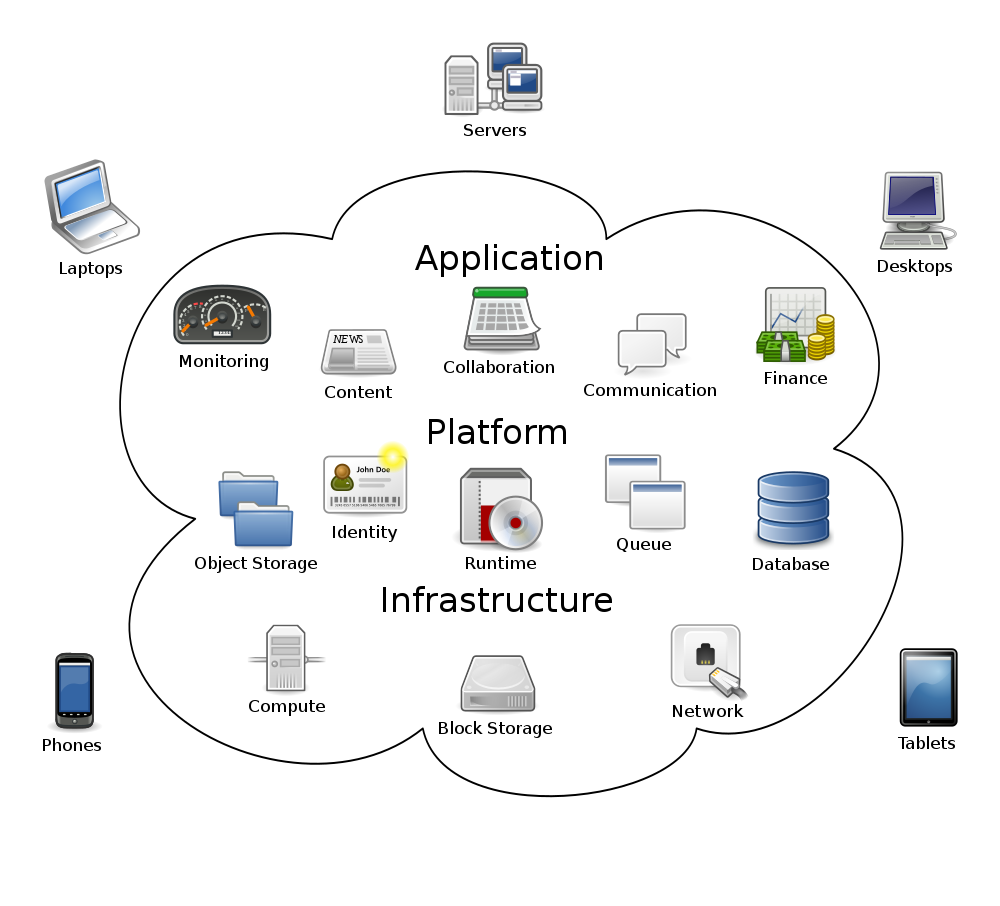User:Shawndouglas/sandbox/sublevel45

If you were alive in the late 2000s and doing most anything related to computers and the internet, you were bound to encounter the latest internet buzzword: cloud computing.[1][2] A certain mysticism was seemingly attached to the concept, that your files and applications could reside on the internet, "out there in the 'cloud.'"[1] "But what is this 'cloud'?" many would ask. A plethora of media articles, journal articles, blogs, and company websites were published to give practically everyone's take on what the cloud was and wasn't meant to be.[3] However, the then growing consensus of cloud computing as networked and scalable architecture meant to rapidly provide application and infrastructure services at reasonable prices to internet users[2][3] largely matches up with today's definition. Pulling from both The Institution of Engineering and Technology[4] and Amazon Web Services[5], we come up with cloud computing as:
an internet-based computing paradigm in which standardized and virtualized resources are used to rapidly, elastically, and cost-effectively provide a variety of globally available, "always-on" computing services to users on a continuous or as-needed basis
Of course, those computing services come in a variety of flavors, the most common being software, platform, and infrastructure "as a service" (SaaS, PaaS, and IaaS, respectively). These conveniently correspond to the underlying architectural layers of the services, with infrastructure at the base, platform on top of that, and software (or application) on top of that.
Figure 1 portrays a simplified visualization of cloud computing architecture layers, as well as examples of activities that happen on those layers. This concept has also been visualized by others using pyramids and pancake stacks of layers, but the concept remains the same. At the base is the computing infrastructure, including the physical data centers and their networking equipment, servers, hypervisors, application programming interfaces (APIs), and operating systems. This infrastructure is the foundation that supports not only applications users want to run but also that acts as the developmental foundation of users not wanting to implement their own infrastructure. On top of all that can be found platforms or middleware, which serve as software development and deployment environments (that include databases, web servers, load balancers, etc.) or connectivity tools for analytics, workflow management, system integration, and security management. And on top of that are applications, typically designed to run optimally in cloud environments and accessed via web browsers or apps using internet—i.e. networking—connectivity and computing devices.[6]
Customers who require application hosting, internet-hosted software development platforms, or underlying computing infrastructure (e.g., data storage, computational time, etc.)—particularly when they can't or don't want to invest in their own hardware—are increasingly turning to the cloud computing paradigm. Even before a worldwide COVID-19 pandemic started to take shape in late 2019, the global cloud services market was expected to reach $266.4 billion by the end of 2020, with Gartner expecting that to represent a 17 percent increase from 2019.[7] As work-from-home practices expanded significantly in 2020 due to the pandemic, expectations that the trend would last post-pandemic pushed estimates of overall cloud-based workloads moving from physical work offices to the cloud to 55 percent by 2022, with the cloud services market reaching $1 trillion by 2030.[8] This growing migration to cloud computing has many implications for organizations of all types, including laboratories.
References
- ↑ 1.0 1.1 Pogue, D. (17 July 2008). "In Sync to Pierce the Cloud". The New York Times. Archived from the original on 05 January 2018. https://web.archive.org/web/20180105205750/https://www.nytimes.com/2008/07/17/technology/personaltech/17pogue.html. Retrieved 21 August 2021.
- ↑ 2.0 2.1 Wang, L.; von Laszewski, G.; Younge, A. et al. (2010). "Cloud Computing: A Perspective Study". New Generation Computing 28: 137–46. doi:10.1007/s00354-008-0081-5. https://scholarworks.rit.edu/cgi/viewcontent.cgi?article=1748&context=other.
- ↑ 3.0 3.1 Chamberlin, B. (28 October 2008). "Cloud Computing: What is it?". BillChamberlin.com. https://www.billchamberlin.com/cloud-computing-what-is-it/. Retrieved 21 August 2021.
- ↑ French, J. (2021). "Cloud computing and web services". The Institution of Engineering and Technology. https://www.theiet.org/publishing/inspec/researching-hot-topics/cloud-computing-and-web-services/. Retrieved 21 August 2021.
- ↑ "Amazon Web Services - Cloud Computing". TutorialsPoint. 2021. https://www.tutorialspoint.com/amazon_web_services/amazon_web_services_cloud_computing.htm. Retrieved 21 August 2021.
- ↑ Maurer, T.; Hinck, G. (31 August 2020). "Cloud Security: A Primer for Policymakers". Carnegie Endowment for International Peace. https://carnegieendowment.org/2020/08/31/cloud-security-primer-for-policymakers-pub-82597. Retrieved 21 August 2021.
- ↑ Costello, K.; Rimol, M. (13 November 2020). "Gartner Forecasts Worldwide Public Cloud Revenue to Grow 17% in 2020". Gartner. https://www.gartner.com/en/newsroom/press-releases/2019-11-13-gartner-forecasts-worldwide-public-cloud-revenue-to-grow-17-percent-in-2020. Retrieved 21 August 2021.
- ↑ Reinicke, C. (30 March 2020). "3 reasons one Wall Street firm says to stick with cloud stocks amid the coronavirus-induced market rout". Market Insider. https://markets.businessinsider.com/news/stocks/wedbush-reasons-own-cloud-stocks-coronavirus-pandemic-tech-buy-2020-3-1029045273#2-the-move-to-cloud-will-accelerate-more-quickly-amid-the-coronavirus-pandemic2. Retrieved 21 August 2021.









